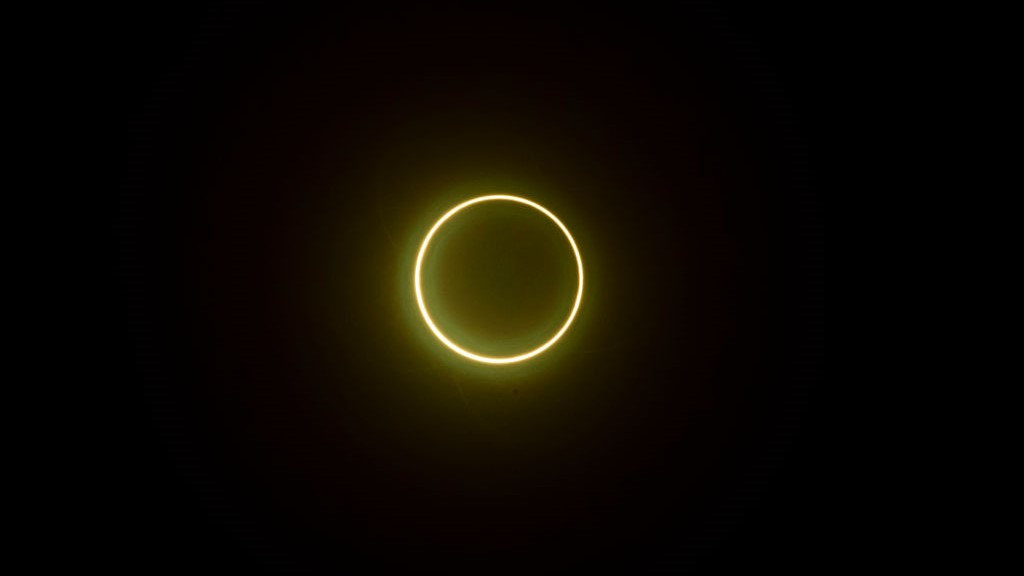All solar eclipses will be 'rings of fire' in the distant future. Here's why

On Wednesday, Oct. 2, people across parts of the Pacific Ocean, southern Chile and southern Argentina will be able to watch as the new moon orbits between the sun and Earth to create a most interesting celestial occurrence: An eclipse of the sun.
This eclipse is an annular solar eclipse, one in which a ring of sunlight is viewed around the moon's image at the center of the spectacle.
In an annular eclipse, the sun is never completely hidden (as in a total eclipse) because on Oct. 2 the moon will be at apogee — the point in its orbit where it is farthest from Earth. The new moon on eclipse day will be 252,597 miles (406,516 kilometers) away. As a consequence, the tip of its dark umbral shadow cone fails to make contact with the Earth. So, like a penny placed atop a nickel, the disk of the moon will appear too small to completely cover the sun. The magnitude, or fraction of the sun's width that the moon covers, means that 7 percent of that width shows all around.

If you're looking for safe optics to view the eclipse, we recommend the Celestron EclipSmart 2x Power Viewers, which have 2x magnification or this travel-friendly solar telescope. You can also consult our guide to photographing the solar eclipse.
You can keep up with all the solar eclipse action with our solar eclipse live blog. We will also be streaming the eclipse live on Space.com, more details on how to watch online will be released closer to the time.
Comparing a total eclipse to an annular eclipse is like comparing night and day. The panoply of phenomena that accompany a total eclipse is remarkable and astronomers will travel halfway around the world to observe and experience them.
An annular eclipse is not like totality: The sky gets no darker than in a deep partial eclipse; the sun's glorious corona, and the chromosphere and "edge effects" such as shadow bands cannot appear. Yet, it is still a spectacular sight, and enthusiasts will go to whatever section of the eclipse track is most easily accessible for them.
And yet there will come a time when the phenomenon of a total eclipse of the sun will become an impossibility, as the moon, as seen from the Earth, will be too small in apparent angular size to cover completely the disk of the sun.
Breaking space news, the latest updates on rocket launches, skywatching events and more!
An everchanging celestial geometry
The moon moves around the Earth in an elliptical orbit. At its absolute closest to the Earth (perigee), the moon can approach to within 221,439 miles (356,371 km), while its absolute farthest from Earth (apogee) is 252,724 miles (406,720 km). The mean distance of the Earth to the moon is 239,071 miles (384,748 km).
In order for a total eclipse to take place, the dark umbral shadow cone of the moon must make contact with the Earth's surface. When the umbra touches down on the Earth, it is in essence, the tip of the shadow cone and in most cases, that dark shadow tends to be, on average, about 80 miles (130 km) in width. Anywhere within that shadow, will experience a total eclipse of the sun, with the dark disk of the moon completely covering the disk of the sun.
But the cone of the moon's shadow – generally speaking – averages only about 235,000 miles (378,000 km) in length.
That's less than the moon's mean distance from Earth.
That's why, when a new moon passes directly between the Earth and the sun, if – generally speaking – it is greater than 235,000 miles (378,000 km) away, the tip of the dark umbral shadow will fail to make contact with Earth; instead, a "negative shadow" known as the antumbra is created and it is from within that shadow – as will be the case on Oct. 2 – that the spectacle of an annular or ring eclipse will be seen.
We are fortunate that, at this particular moment in history, there are times when the new moon can come closer than average to the Earth and on such occasions, the tip of its dark umbral shadow can reach the Earth and produce a total solar eclipse.
The ultimate extinction of total eclipses of the sun
From July 1969 to December 1972, twelve Apollo astronauts left a series of laser reflectors on the moon's surface. Since then, astronomers on Earth have routinely bounced lasers off those reflectors. By timing the round trip of those laser pulses, the moon's distance can be measured with great accuracy. Analysis of these measurements has demonstrated that the mean distance of the moon to the Earth is increasing at the rate of 1.5 inches (about 3.8 cm) each year.
Why is this happening?
The moon's motion is strongly perturbed by the attraction of the sun, and in a lesser way by that of the planets and by the Earth. Due to tidal affects the moon is slowly moving farther from the Earth, spiraling outward and ascending to a more distant orbit. Of course, as the moon moves progressively farther away, its apparent size diminishes until finally it will reach a point where it will be too far for its dark umbral shadow cone to reach Earth and thus precluding the occurrence of total solar eclipses.
In his book, "More Mathematical Astronomy Morsels" (Willmann-Bell, Inc. 2002), the reputable celestial calculator, Jean Meeus, says that it is doubtful that the moon's current rate of recession from Earth of 12.5 feet (3.8 meters) per century will remain constant. If it did, it would take 1.21 billion years before total eclipses of the sun become impossible.
However, if we also take into account the fact that the eccentricity (the shape) of the Earth's orbit varies at a faster rate than does the very slow, gradual increase of the moon’s distance, we probably would not have to wait as long.
"Consequently,' notes Meeus, "from 620 million to 1210 million years in the future, there will be periods during which total solar eclipses are alternately possible and impossible, until finally those totals remain impossible forever."

Joe Rao is Space.com's skywatching columnist, as well as a veteran meteorologist and eclipse chaser who also serves as an instructor and guest lecturer at New York's Hayden Planetarium. He writes about astronomy for Natural History magazine, Sky & Telescope and other publications. Joe is an 8-time Emmy-nominated meteorologist who served the Putnam Valley region of New York for over 21 years. You can find him on Twitter and YouTube tracking lunar and solar eclipses, meteor showers and more. To find out Joe's latest project, visit him on Twitter.

